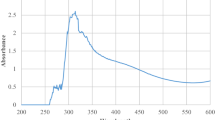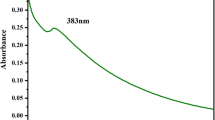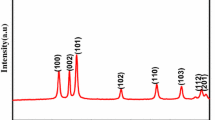Abstract
Physical and chemical methods for production of nanoparticles (NPs) are not only harmful for environment but also toxic for living organism. The present study attempts to synthesize ZnO NPs using the natural plant extract of Fagonia cretica. The phytochemical screening of F. cretica water extract was performed to check the presence of biologically active compounds like alkaloids, tannins, carbohydrates, proteins, phenols, saponins, flavonoids, and steroids. Well-prepared ZnO NPs given sharp absorption peak at 362 were confirmed by UV–visible. XRD analysis showed the ZnO NPs having wurtzite hexagonal structure with crystalline form. TEM analysis endorses flower-shaped ZnO nanoparticles ~ 100–1000 nm. FTIR spectrum suggested the involvement of phenolic groups and amino acids and amide linkages in protein performs as the stabilizing agent in the synthesis of ZnO NPs. The ZnO NPs showed strong antibacterial behavior against two bacterial strains Gram-positive bacteria Staphylococcus aureus and Gram-negative bacteria Escherichia coli. In addition, ZnO NPs exhibited strong antioxidant activity of 79%:85.6%:89.9% at 5 μg/mL:10 μg/mL:5 μg/mL concentration of ZnO NPs respectively. This work indicates that Fagonia is considered to be appropriate and promising candidate for extending the innovative applications in the field of medicine and industry and also helpful and useful to the scientific communities.








Similar content being viewed by others
Data Availability
The authors confirm that the data supporting the findings of this study are available within the article and its supporting information.
References
Panichikkal, J., Jose, A., Sreekumaran, S., Ashokan, A. K., Baby, C. S., Krishnankutty, R.E. (2021). Biofilm and biocontrol modulation of Paenibacillus sp. CCB36 by supplementation with zinc oxide nanoparticles and chitosan nanoparticles. Applied Biochemistry and Biotechnology. https://doi.org/10.1007/s12010-021-03710-w.
Abdollahi, S., Toupchian, O., Jayedi, A., Meyre, D., Tam, V., Soltani, S. (2020). Zinc supplementation and body weight: a systematic review and dose-response meta-analysis of randomized controlled trials. Advances in Nutrition, 11. https://doi.org/10.1093/advances/nmz084.
Hussan, F., Krishna, D., Preetam, V. C., Reddy, P. B., Gurram, S. (2022) Dietary supplementation of nano zinc oxide on performance, carcass, serum and meat quality parameters of commercial broilers. Biological Trace Element Research, 200. https://doi.org/10.1007/s12011-021-02635-z.
Dong, H.,Virtanen, S. (2022) Influence of bovine serum albumin on biodegradation behavior of pure Zn. Journal of Biomedical Materials Research - Part B Applied Biomaterials, 110. https://doi.org/10.1002/jbm.b.34901.
Saif, M. S., Zafar, A., Waqas, M., Hassan, S. G., ul Haq, A., Tariq, T., Batool, S., Dilshad, M., Hasan, M., Shu, X. (2021). Phyto-reflexive zinc oxide nano-flowers synthesis: an advanced photocatalytic degradation and infectious therapy. Journal of Materials Research and Technology. https://doi.org/10.1016/j.jmrt.2021.05.107.
Luo, F., Wang, M., Huang, L., Wu, Z., Wang, W., Zafar, A., Tian, Y., Hasan, M., & Shu, X. (2020). Synthesis of zinc oxide Eudragit FS30D nanohybrids: Structure, characterization, and their application as an intestinal drug delivery system. ACS Omega. https://doi.org/10.1021/acsomega.0c01216
Harini, B., Rajeshkumar, S., Roy, A. (2022). Biomedical application of chitosan and Piper longum-assisted nano zinc oxide–based dental varnish. Applied Biochemistry and Biotechnology, 194. https://doi.org/10.1007/s12010-021-03712-8.
Akbar, S., Haleem, K. S., Tauseef, I., Rehman, W., Ali, N., & Hasan, M. (2018). Raphanus sativus mediated synthesis, characterization and biological evaluation of zinc oxide nanoparticles. Nanoscience and Nanotechnology Letters. https://doi.org/10.1166/nnl.2017.2550
Hamam, K. J., Alomari, M. I.. (2017). A study of the optical band gap of zinc phthalocyanine nanoparticles using UV–Vis spectroscopy and DFT function. Applied Nanoscience (Switzerland), 7. https://doi.org/10.1007/s13204-017-0568-9.
Rani, M., Keshu, Shanker, U. (2021). Biogenic synthesis of zinc nanostructures: characterization and mechanisms, In: Zinc-Based Nanostructures for Environmental and Agricultural Applications. Nanobiotechnology for Plant Protection, pp. 65–91. https://doi.org/10.1016/b978-0-12-822836-4.00003-3.
Nam, P. H., Phuc, N. X., Linh, P. H., Lu, L. T., Manh, D. H., Phong, P. T., Lee, I. J. (2018). Effect of zinc on structure, optical and magnetic properties and magnetic heating efficiency of Mn1-xZnxFe2O4 nanoparticles. Physica B: Condensed Matter, 550. https://doi.org/10.1016/j.physb.2018.09.004.
Hasan, M., Altaf, M., Zafar, A., Hassan, S. G., Ali, Z., Mustafa, G., Munawar, T., Saif, M. S., Tariq, T., Iqbal, F., Khan, M. W., Mahmood, A., Mahmood, N., & Shu, X. (2021). Bioinspired synthesis of zinc oxide nano-flowers: A surface enhanced antibacterial and harvesting efficiency. Materials Science and Engineering C. https://doi.org/10.1016/j.msec.2020.111280
Cao, D., Shu, X., Zhu, D., Liang, S., Hasan, M., & Gong, S. (2020). Lipid-coated ZnO nanoparticles synthesis, characterization and cytotoxicity studies in cancer cell. Nano Convergence. https://doi.org/10.1186/s40580-020-00224-9
Luo, F., Fu, Z., Wang, M., Ke, Z., Wang, M., Wang, W. X., Hasan, M., & Shu, X. (2021). Growth performance, tissue mineralization, antioxidant activity and immune response of oreochromis niloticus fed with conventional and gluconic acid zinc dietary supplements. Aquaculture Nutrition. https://doi.org/10.1111/anu.13234
del Buono, D., Luzi, F., Tolisano, C., Puglia, D., di Michele, A. (2022). Synthesis of a lignin/zinc oxide hybrid nanoparticles system and its application by nano-priming in maize. Nanomaterials, 12. https://doi.org/10.3390/nano12030568.
Iqbal, T., Raza, A., Zafar, M., Afsheen, S., Kebaili, I., Alrobei, H. (2022). Plant-mediated green synthesis of zinc oxide nanoparticles for novel application to enhance the shelf life of tomatoes. Applied Nanoscience (Switzerland), 12. https://doi.org/10.1007/s13204-021-02238-z.
Akhtar, N., Ilyas, N., Meraj, T. A., Pour-Aboughadareh, A., Sayyed, R. Z., Mashwani, Z. U. R., Poczai, P. (2022). Improvement of plant responses by nanobiofertilizer: a step towards sustainable agriculture. Nanomaterials, 12. https://doi.org/10.3390/nano12060965.
Khan, S. U., Anjum, S. I., Ansari, M. J., Khan, M. H. U., Kamal, S., Rahman, K., Shoaib, M., Man, S., Khan, A. J., Khan, S. U., Khan, D. (2019). Antimicrobial potentials of medicinal plant’s extract and their derived silver nanoparticles: a focus on honey bee pathogen. Saudi Journal of Biological Sciences, 26. https://doi.org/10.1016/j.sjbs.2018.02.010.
Çulha, M., Kalay, Ş., Sevim, E., Pinarbaş, M., Baş, Y., Akpinar, R., Karaoğlu, Ş. A. (2017). Biocidal properties of maltose reduced silver nanoparticles against American foulbrood diseases pathogens. BioMetals, 30. https://doi.org/10.1007/s10534-017-0055-5.
Santos, R. C. V., Lopes, L. Q. S., dos S. Alves, C. F., Fausto, V. P., Pizzutti, K., Barboza, V., de Souza, M. E., Raffin, R. P., Gomes, P., Takamatsu, D., Morinaga, Y., Boligon, A. A., Athayde, M. L., Felippi, C. C., de Almeida Vaucher, R. (2014). Antimicrobial activity of tea tree oil nanoparticles against American and European foulbrood diseases agents. Journal of Asia-Pacific Entomology, 17. https://doi.org/10.1016/j.aspen.2014.02.003.
Naz, G., Shabbir, M., Ramzan, M., Haq, B. U., Arshad, M., Tahir, M. B., Hasan, M., Ahmed, R.. (2022). Synergistic effect of Cux/Mgx and Zn1−xO for enhanced photocatalytic degradation and antibacterial activity. Physica B: Condensed Matter, 624. https://doi.org/10.1016/j.physb.2021.413396.
Narasaiah, B. P., Mandal, B. K. (2020). Waste to wealth: a solution to textile dyes related pollution. Materials Research Express, 7. https://doi.org/10.1088/2053-1591/ab6c22.
Al-Buriahi, A. K., Al-Gheethi, A. A., Senthil Kumar, P., Radin Mohamed, R. M. S., Yusof, H., Alshalif, A. F., Khalifa, N. A. (2022). Elimination of rhodamine B from textile wastewater using nanoparticle photocatalysts: a review for sustainable approaches. Chemosphere, 287. https://doi.org/10.1016/j.chemosphere.2021.132162.
Mobarok, M. H., Luber, E. J., Bernard, G. M., Peng, L., Wasylishen, R. E., Buriak, J. M. (2014). Phase-pure crystalline zinc phosphide nanoparticles: synthetic approaches and characterization. Chemistry of Materials, 26. https://doi.org/10.1021/cm500557f.
Mukhtar, F., Munawar, T., Nadeem, M. S., ur Rehman, M. N., Batool, S., Hasan, M., Riaz, M., ur Rehman, K., Iqbal, F. (2021). Highly efficient tri-phase TiO2–Y2O3–V2O5 nanocomposite: structural, optical, photocatalyst, and antibacterial studies. Journal of Nanostructure in Chemistry. https://doi.org/10.1007/s40097-021-00430-9.
Jamil, R., Ali, R., Loomba, S., Xian, J., Yousaf, M., Khan, K., Shabbir, B., McConville, C. F., Mahmood, A., Mahmood, N. (2021). The role of nitrogen in transition-metal nitrides in electrochemical water splitting. Chem Catalysis, 1. https://doi.org/10.1016/j.checat.2021.06.014.
Mahmood, N., Khan, H., Tran, K., Kuppe, P., Zavabeti, A., Atkin, P., Ghasemian, M. B., Yang, J., Xu, C., Tawfik, S. A., Spencer, M. J. S., Ou, J. Z., Khoshmanesh, K., McConville, C. F., Li, Y., Kalantar-Zadeh, K. (2021). Maximum piezoelectricity in a few unit-cell thick planar ZnO – a liquid metal-based synthesis approach. Materials Today, 44. https://doi.org/10.1016/j.mattod.2020.11.016.
Hasan, M., Ullah, I., Zulfiqar, H., Naeem, K., Iqbal, A., Gul, H., Ashfaq, M., & Mahmood, N. (2018). Biological entities as chemical reactors for synthesis of nanomaterials: Progress, challenges and future perspective. Materials Today Chemistry. https://doi.org/10.1016/j.mtchem.2018.02.003
Mohsin, M., Bhatti, I. A., Ashar, A., Khan, M. W., Farooq, M. U., Khan, H., Hussain, M. T., Loomba, S., Mohiuddin, M., Zavabeti, A., Ahmad, M., Yousaf, M., Mahmood, N. (2021). Iron-doped zinc oxide for photocatalyzed degradation of humic acid from municipal wastewater. Applied Materials Today, 23. https://doi.org/10.1016/j.apmt.2021.101047.
Hasan, M., Teng, Z., Iqbal, J., Awan, U., Meng, S., Dai, R., Qing, H., Deng, Y. (2013). Assessment of bioreducing and stabilizing potential of dragon’s blood (dracaena cochinchinensis, Lour. S. C. Chen) resin extract in synthesis of silver nanoparticles. Nanoscience and Nanotechnology Letters. https://doi.org/10.1166/nnl.2013.1600.
Hasan, M., Iqbal, J., Awan, U., Saeed, Y., Ranran, Y., Liang, Y., Dai, R., & Deng, Y. (2015). Mechanistic study of silver nanoparticle’s synthesis by Dragon’s blood resin ethanol extract and antiradiation activity. Journal of Nanoscience and Nanotechnology. https://doi.org/10.1166/jnn.2015.9090
Demissie, M. G., Sabir, F. K., Edossa, G. D., Gonfa, B. A. (2020). Synthesis of zinc oxide nanoparticles using leaf extract of Lippia adoensis (Koseret) and evaluation of its antibacterial activity. Journal of Chemistry. 2020. https://doi.org/10.1155/2020/7459042.
Jayachandran, A., T.R., A., Nair, A. S. (2021). Green synthesis and characterization of zinc oxide nanoparticles using Cayratia pedata leaf extract. Biochemistry and Biophysics Reports, 26. https://doi.org/10.1016/j.bbrep.2021.100995.
Jan, H., Shah, M., Usman, H., Khan, M. A., Zia, M., Hano, C., Abbasi, B. H. (2020). Biogenic synthesis and characterization of antimicrobial and antiparasitic zinc oxide (ZnO) nanoparticles using aqueous extracts of the Himalayan columbine (Aquilegia pubiflora). Frontiers in Materials, 7. https://doi.org/10.3389/fmats.2020.00249.
Jayappa, M. D., Ramaiah, C. K., Kumar, M. A. P., Suresh, D., Prabhu, A., Devasya, R. P., Sheikh, S. (2020). Green synthesis of zinc oxide nanoparticles from the leaf, stem and in vitro grown callus of Mussaenda frondosa L.: characterization and their applications. Applied Nanoscience (Switzerland), 10. https://doi.org/10.1007/s13204-020-01382-2.
Bala, N., Saha, S., Chakraborty, M., Maiti, M., Das, S., Basu, R., Nandy, P. (2015) Green synthesis of zinc oxide nanoparticles using Hibiscus subdariffa leaf extract: effect of temperature on synthesis, anti-bacterial activity and anti-diabetic activity. RSC Advances, 5. https://doi.org/10.1039/c4ra12784f.
Patel, D., Kumar, V. (2020). Protective effects of fagonia cretica L. Extract in cafeteria diet induced obesity in wistar rats. Journal of Natural Remedies. 20. https://doi.org/10.18311/jnr/2020/25223.
Naeem, K., Yawar, W., Muhammad, B., Rehana, I. (2014). Assessment of macronutrients and heavy metals in Fagonia cretica linn of Pakistan by atomic spectroscopy. Bulletin of the Chemical Society of Ethiopia, 28. https://doi.org/10.4314/bcse.v28i2.2.
Ran, Y., Xu, B., Wang, R., Gao, Q., Jia, Q., Hasan, M., Shan, S., Ma, H., Dai, R., Deng, Y., Qing, H. (2016). Dragon’s blood extracts reduce radiation-induced peripheral blood injury and protects human megakaryocyte cells from GM-CSF withdraw-induced apoptosis. Physica Medica, 32. https://doi.org/10.1016/j.ejmp.2015.09.010.
Ran,Y., Wang, R., Hasan, M., Jia, Q., Tang, B., Shan, S., Deng, Y., Qing, H. (2014). Radioprotective effects of dragon’s blood and its extracts on radiation-induced myelosuppressive mice. Journal of Ethnopharmacology. 154. https://doi.org/10.1016/j.jep.2014.04.036.
Sarkar, T., Bharadwaj, K. K., Salauddin, M., Pati, S., Chakraborty R. (2022). Phytochemical characterization, antioxidant, anti-inflammatory, anti-diabetic properties, molecular docking, pharmacokinetic profiling, and network pharmacology analysis of the major phytoconstituents of raw and differently dried Mangifera indica (Himsagar cultivar): an in vitro and in silico investigations. Applied Biochemistry and Biotechnology, 194. https://doi.org/10.1007/s12010-021-03669-8.
Sarkar, T., Salauddin, M., Pati, S., Sheikh, H. I., Chakraborty R. (2021). Application of raw and differently dried Pineapple (Ananas comosus) pulp on Rasgulla (sweetened Casein Ball) to enhance its phenolic profile, shelf life, and in-vitro digestibility characteristics. Journal of Food Processing and Preservation, 45. https://doi.org/10.1111/jfpp.15233.
Munawar, T., Mukhtar, F., Nadeem, M. S., Riaz, M., Naveed ur Rahman, M., Mahmood, K., Hasan, M., Arshad, M. I., Hussain, F., Hussain, A., Iqbal F. (2020). Novel photocatalyst and antibacterial agent; direct dual Z-scheme ZnO–CeO2-Yb2O3 heterostructured nanocomposite. Solid State Sciences. https://doi.org/10.1016/j.solidstatesciences.2020.106446.
Qureshi, H., Asif, S., Ahmed, H., Al-Kahtani, H. A., Hayat K. (2016). Chemical composition and medicinal significance of Fagonia cretica: a review. Natural Product Research. 30. https://doi.org/10.1080/14786419.2015.1036268.
Iqbal, P., Ahmed, D., Asghar, M. N. (2014). A comparative in vitro antioxidant potential profile of extracts from different parts of Fagonia cretica. Asian Pacific Journal of Tropical Medicine. 7. https://doi.org/10.1016/S1995-7645(14)60277-7.
Hussain, A., Zia, M., Mirza, B. (2007). Cytotoxic and antitumor potential of Fagonia cretica L.. Turkish Journal of Biology. 31.
Anjum, M. I., Ahmed, E., Sharif, A., Jabbar, A., Malik, A., Hussain, T., Farooqi, Z. H., Nawaz, A. (2014). A new triterpene glycoside from Fagonia cretica. Asian Journal of Chemistry. 26. https://doi.org/10.14233/ajchem.2014.17087.
Ashfaq, M., Verma, N., Khan, S. (2017). Highly effective Cu/Zn-carbon micro/nanofiber-polymer nanocomposite-based wound dressing biomaterial against the P. aeruginosa multi- and extensively drug-resistant strains. Materials Science and Engineering C, 77. https://doi.org/10.1016/j.msec.2017.03.187.
Zulfiqar, H., Zafar, A., Rasheed, M. N., Ali, Z., Mehmood, K., Mazher, A., Hasan, M., & Mahmood, N. (2019). Synthesis of silver nanoparticles using: Fagonia cretica and their antimicrobial activities. Nanoscale Advances. https://doi.org/10.1039/c8na00343b
Aldeen, T. S., Ahmed Mohamed, H. E., Maaza, M. (2022). ZnO nanoparticles prepared via a green synthesis approach: physical properties, photocatalytic and antibacterial activity. Journal of Physics and Chemistry of Solids, 160. https://doi.org/10.1016/j.jpcs.2021.110313.
Sarkar, T., Salauddin, M., Sheikh, H. I., Pati, S., Chakraborty, R. (2022). Effect of drying on vitamin, carotene, organic acid, mineral composition, and microstructural properties of mango (Mangifera indica). Journal of Food Processing and Preservation. 46. https://doi.org/10.1111/jfpp.16237.
Saleem, S., Jameel, M. H., Akhtar, N., Nazir, N., Ali, A., Zaman, A., Rehman, A., Butt, S., Sultana, F., Mushtaq, M., Zeng, J. H., Amami, M., Althubeiti, K. (2022). Modification in structural, optical, morphological, and electrical properties of zinc oxide (ZnO) nanoparticles (NPs) by metal (Ni, Co) dopants for electronic device applications. Arabian Journal of Chemistry, 15. https://doi.org/10.1016/j.arabjc.2021.103518.
Rajiv, P., Rajeshwari, S., Venckatesh, R. (2013). Bio-Fabrication of zinc oxide nanoparticles using leaf extract of Parthenium hysterophorus L. and its size-dependent antifungal activity against plant fungal pathogens. Spectrochimica Acta - Part A: Molecular and Biomolecular Spectroscopy, 112. https://doi.org/10.1016/j.saa.2013.04.072.
Vijayakumar, S., Krishnakumar, C., Arulmozhi, P., Mahadevan, S., Parameswari, N., (2018) Biosynthesis, characterization and antimicrobial activities of zinc oxide nanoparticles from leaf extract of Glycosmis pentaphylla (Retz.) DC. Microbial Pathogenesis. 116. https://doi.org/10.1016/j.micpath.2018.01.003.
Jamdagni, P., Khatri, P., Rana, J. S. (2018). Green synthesis of zinc oxide nanoparticles using flower extract of Nyctanthes arbor-tristis and their antifungal activity. Journal of King Saud University – Science, 30. https://doi.org/10.1016/j.jksus.2016.10.002.
Fakhari, S., Jamzad, M., Kabiri Fard, H. (2019). Green synthesis of zinc oxide nanoparticles: a comparison. Green Chemistry Letters and Reviews, 12. https://doi.org/10.1080/17518253.2018.1547925.
Hasnidawani, J. N., Azlina, H. N., Norita, H., Bonnia, N. N., Ratim, S., Ali, E. S. (2016). Synthesis of ZnO nanostructures using sol-gel method. Procedia Chemistry, 19. https://doi.org/10.1016/j.proche.2016.03.095.
Suresh, J., Pradheesh, G., Alexramani, V., Sundrarajan, M., Hong, S. I. (2018). Green synthesis and characterization of zinc oxide nanoparticle using insulin plant (Costus pictus D. Don) and investigation of its antimicrobial as well as anticancer activities. Advances in Natural Sciences: Nanoscience and Nanotechnology, 9. https://doi.org/10.1088/2043-6254/aaa6f1.
Sarkar, T., Saha, S. K., Salauddin, M., Chakraborty, R. (2021). Drying kinetics, Fourier-transform infrared spectroscopy analysis and sensory evaluation of sun, hot-air, microwave and freeze dried mango leather. Journal of Microbiology, Biotechnology and Food Sciences, 10. https://doi.org/10.15414/jmbfs.3313.
Talreja, N., Ashfaq, M., Chauhan, D., Mera, A. C., Rodríguez, C. A., Mangalaraja, R. V. (2021). A Zn-doped BiOI microsponge-based photocatalyst material for complete photodegradation of environmental contaminants. New Journal of Chemistry, 45. https://doi.org/10.1039/d1nj03415d.
Sánchez-López, A. L., Perfecto-Avalos, Y., Sanchez-Martinez, A., Ceballos-Sanchez, O., Sepulveda-Villegas, M., Rincón-Enríquez, G., Rodríguez-González, V., Garcia-Varela, R., Lozano, L. M., Eloyr Navarro-López, D., Sanchez-Ante, G., Corona-Romero, K., López-Mena, E. R. (2022). Influence of erbium doping on zinc oxide nanoparticles: structural, optical and antimicrobial activity. Applied Surface Science, 575. https://doi.org/10.1016/j.apsusc.2021.151764.
Yudasari, N., Wiguna, P. A., Handayani, W., Suliyanti, M. M., Imawan, C. (2021). The formation and antibacterial activity of Zn/ZnO nanoparticle produced in Pometia pinnata leaf extract solution using a laser ablation technique. Applied Physics A: Materials Science and Processing, 127. https://doi.org/10.1007/s00339-020-04197-8.
Zafar, A., Tariq, T., Hasan, M., Nazar, M., Rasheed, M. N., Mahmood, N., Shu, X. (2021). Green-maturation of cobalt-oxide nano-sponges for reinforced bacterial apoptosis. Colloids and Interface Science Communications, 45. https://doi.org/10.1016/j.colcom.2021.100531.
Hasan, M., Zafar, A., Shahzadi, I., Luo, F., Hassan, S. G., Tariq, T., Zehra, S., Munawar, T., Iqbal, F., & Shu, X. (2020). Fractionation of biomolecules in Withania coagulans extract for bioreductive nanoparticle synthesis, antifungal and biofilm activity. Molecules. https://doi.org/10.3390/molecules25153478
Author information
Authors and Affiliations
Contributions
MH and SIA designed the experiment; RH and TT performed the experiments. AZ, MW, and MAN analyzed the results. RH wrote the manuscript. FT and MH edited the final version of the manuscript.
Corresponding authors
Ethics declarations
Ethics Approval
This article does not contain any studies with human participants or animals performed by any of the authors.
Consent to Participate
The authors agreed to participate in this work.
Consent for Publication
The authors agreed to publish this work.
Conflict of Interest
The authors declare no competing interests.
Additional information
Publisher's Note
Springer Nature remains neutral with regard to jurisdictional claims in published maps and institutional affiliations.
Rights and permissions
Springer Nature or its licensor holds exclusive rights to this article under a publishing agreement with the author(s) or other rightsholder(s); author self-archiving of the accepted manuscript version of this article is solely governed by the terms of such publishing agreement and applicable law.
About this article
Cite this article
Hussain, R., Zafar, A., Hasan, M. et al. Casting Zinc Oxide Nanoparticles Using Fagonia Blend Microbial Arrest. Appl Biochem Biotechnol 195, 264–282 (2023). https://doi.org/10.1007/s12010-022-04152-8
Accepted:
Published:
Issue Date:
DOI: https://doi.org/10.1007/s12010-022-04152-8




